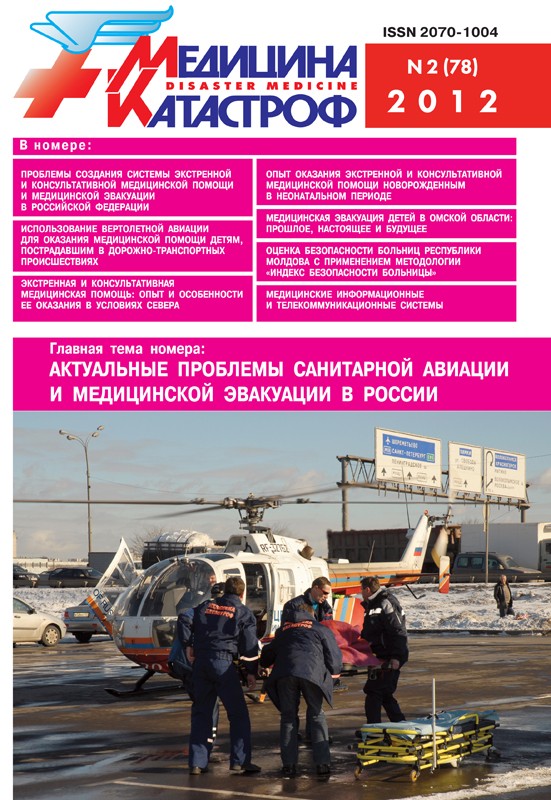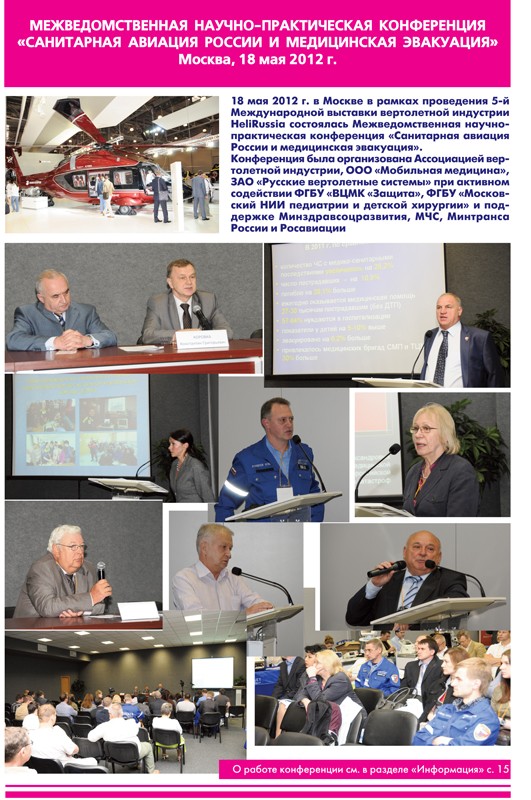ACTUAL PROBLEMS OF EMERGENCY CONSULTATIVE MEDICAL CARE PROVISION AND OF MEDICAL EVACUATION
1. Goncharov S.F., Garmash O.A. Problems of Creation of System of Emergency and Consultative Medical Care and of Medical Evacuation in Russian Federation
The problems of creation of system of emergency and consultative medical care and of medical evacuation in the Russian Federation are dealt with. The everyday activity of emergency and consultative medical care and medical evacuation units is analyzed, as well as the structure of calls for service of specialists of various profiles and the data on flights of medical personnel and so on. Much attention is paid to the issues of aircraft use in the activity of the units. Some suggestions on enhancement of the units work elaborated by colleagues of All Russian Center for Disaster Medicine “Zaschita”are presented.
Key words: aircraft, emergency and consultative medical care, emergency situations, medical evacuation, medical evacuation, road traffic accidents, sanitary aviation evacuation, territorial centers for disaster medicine
2. Suvorov S.G., Rosinov V.M., Chogovadze G.A., Divilina Yu.V., Ezel’skaya L.V., Makhnev V.G. Use of Helicopters for Medical Care Provision to Children Victims of Road Traffic Accidents
The data of comparative analysis of two modes of use of ambulance helicopters for evacuation of 180 children injured in road traffic accidents to the stage of specialized medical care are presented. The data embrace 2001–2011 period and deal with casualty evacuation from accident site and interhospital transfers from medical facilities of Moscow Oblast municipalities.
The preparation of interhospital transfer to a specialized multifield pediatric hospital (level 1 trauma center) included casualty triage to separate hard cases in need of specialized (including high-tech) medical care. The children evacuated from en-route hospitals had significantly higher severity of injuries and state and needed substitution of vital organs’ functions and surgical intervention more often. The length of stay in resuscitation and intensive care units and in hospital was statistically significantly higher than of those evacuated from the accident site. The use of ambulance helicopters for interhospital transfers to the stage of specialized medical care is more expedient and efficient from medical and economic points of view considering use of resource-intensive technologies.
Key words: children, helicopter, interhospital transfer, medical evacuation, road traffic accident, road traffic traumatism
3. Sotnikov V.A., Olesov I.I., Argunova P.S. Emergency Consultative Medical Care: Experience and Specifics of its Delivery in Northern Environment
The experience and specifics of emergency consultative medical care delivery and medical evacuation in the Republic of Sakha Yakutia are analyzed. Some suggestions on further improvements in the sphere are made.
Key words: air transportation, emergency consultative medical care, medical evacuation, Republic of Sakha Yakutia
4. Khovalyg D.A. Specifics of Organization and Delivery of Emergency Consultative Medical Care and of Medical Evacuation in the Republic of Tyva
Specifics of organization and delivery of emergency consultative medical care and of medical evacuation in the Republic of Tyva are discussed. Some suggestions are made on improvements in the activity.
Key words: air transportation, emergency consultative medical care, medical evacuation, Republic of Tyva, territorial center for disaster medicine
5. Gromut A.A., Fed’ko R.V., Gromut P.A., Ulyanov A.A., Birger A.L. Experience of Delivery of Emergency and Consultative Medical Care to Newborns in Neonatal Period
The experience of emergency and consultative medical care provision to newborns in neonatal period in Khanty-Mansi Autonomous Area (Yugra) is presented. The activity of the Center for Disaster Medicine in organizing sanitary aviation evacuation of newborns to perinatal centers is analyzed. The conclusion is drawn that sanitary aviation evacuation of newborns in the local environment demands better noise and vibration protection of planes and helicopters as well as other improvements.
Key words: Center for Disaster Medicine, emergency consultative medical care, Khanty-Mansi Autonomous Area (Yugra), neonatal period, newborns, perinatal centers, sanitary aviation evacuation
6. Sambrat P.A., Dyrul A.K., Kologreev V.A., Chernyshov A.K., Pisklakov A.V. Medical Evacuation of Children in Omsk Oblast: Past, Present and Prospects
The specifics of medical evacuation of children in Omsk Oblast are discussed. The conclusion is drawn that reanimobiles can be used when distances are below 300 km and helicopters without special equipment in other cases.
Key words: children, helicopters, medical evacuation, Omsk Oblast, reanimobiles, sanitary aviation evacuation
7. Matskevich V.A., Baryshnikov K.A., Motin A.V., Golikov M.V. Interhospital Transfer of Patients in Critical Condition in Krasnoyarsk Krai
Various aspects of organization of interhospital transfer of patients in critical condition in Krasnoyarsk Krai are analyzed. An algorithm of transfer of patients in critical condition from district hospitals to Krai hospitals is presented.
Key words: aeroplanes, emergency and consultative medical care, helicopters, interhospital transfer, Krasnoyarsk Krai, patients in critical condition, sanitary aviation evacuation
8. Banin I.N., Osykovyi A.V., Balabaev G.A. Experience and Prospects of Use of Helicopters for Emergency Consultative Medical Care Provision and Sanitary Aviation Evacuation in Voronezh Oblast
Experience and prospects of use of helicopters for emergency first aid care delivery, emergency consultative medical care provision and for sanitary aviation evacuation in Voronezh Oblast are discussed.
The conclusions are drawn on the requirements for efficient introduction of medical aviation technologies with helicopters use into health service activities.
Key words: aviation evacuation, emergency consultative medical care, emergency first aid care, helicopters, Voronezh Oblast
ORGANIZATION AND TACTICS OF DISASTER MEDICINE SERVICE
9. Lobanov A.I. Perfection of Paramilitary Mine-Rescue Units of EMERCOM of Russia: Medical Aspects
The reasons and purpose of inclusion of departmental paramilitary mine-rescue units into EMERCOM structure are analyzed. Normative and legal basis of the issue is presented. Complex-approach based suggestions are tabled on optimization of medical and sanitary support of rescue activity in mine accidents. Possible ways of engaging mine rescuers in above-ground rescue operations in emergency situations on hazardous facilities within the alignment of forces of United Russian System of Disaster Management are discussed.
Key words: All Russian Service for Disaster Medicine, emergency situations, medical and sanitary support, mine accidents, paramilitary mine-rescue units of EMERCOM, United Russian System of Disaster Management
CLINICAL ASPECTS OF DISASTER MEDICINE
The criteria of objective quantitative evaluation of psychophysiological status of drivers with the use of computer instrumental psychophysiology methods are discussed. The limits are defined of the relative psychophysiological norm in different modes of testing of functional asymmetry status in variety of groups of patients.
Key words: computer instrumental psychophysiology, drivers, functional asymmetry, integral pictorial profile (criterion) of functional asymmetry, ipsilateral and contralateral visual datastream, normative psychophysiological status, outdoor advertising
11. Avetisov G.M., Goncharov S.F. Problems of Realization of Iodine Prophylaxis of Population in Radiation Accident with Radioiodine Release
The roots of unpreparedness for iodine prophylaxis of population, if required, in territories dangerously close to nuclear power plants of Russia are discussed. The recommendations of WHO on the problem and experience of Belarus and Ukraine in the issue of state regulation of planning, organizing and realization of iodine prophylaxis of population are analyzed.
The conclusion is drawn that the optimal solution of the problem requires federal-level normative documents stating the necessity and regulating the procedure of planning, organizing and implementation, if the need arises, of iodine prophylaxis of population in territories within 1 000 km from active nuclear power plants. At the same time it is essential to approve “Provisions on organization of cooperation of federal executive bodies, country’s atomic energy authority, executive bodies of subjects of the Russian Federation, local authorities and a nuclear plant operating entity in case of radiation accident at a plant”.
Key words: iodine prophylaxis, nuclear power plants, population, radiation accident, radioiodines
12. Sharshov F.G., Spiridonova E.A., Akin’shin A.V., Rumyantsev S.A., Prometnoy D.V., Chernozubenko A.V. Rostov Oblast Based Analysis of Ambulance Teams Skills Level in Organization and Provision of Child Victim Care
Practical skills level of ambulance personnel (doctors and paramedical workers) of Rostov Oblast in emergency medical care of injured children are presented. The conclusion is drawn that low level of theoretical preparation and practical skills is a crucial factor in limiting care scope at prehospital stage.
Key words: ambulance teams, emergency medical care, practical skills, Rostov Oblast, traumas in children
13. Gundorova R.A., Leparskaya N.L., Zinoviev M.Yu., Shaldin P.I. Analysis of Time Interval of Onset of Retinal Detachment in Eye Traumas in Emergency Situations
The rate of traumatic retinal detachment in patients with penetrating wounds without intraocular foreign body and with contusion traumas hospitalized at Department of eye trauma, reconstructive and plastic surgery of the Helmholtz Moscow Research Institute of Eye Diseases is analyzed.
Time intervals of onset of retinal detachment after initial handling of traumas depending on trauma type and on severity of concomitant changes are presented.
Key words: contusion, cornea wound, corneosclera wound, emergency situations, eye trauma, penetrating wound, sclera wound, traumatic retinal detachment
SANITARY-ANTIEPIDEMIC (PREVENTION) MEASURES IN EMERGENCIES
14. Butaev T.M., Kabolova Z.Z., Tedeeva L.U., Batrak N.I. Modern Organization Principles of Sanitary and Epidemiological Supervision in Emergency Situations Caused by Catastrophic Floods
Modern organization principles of sanitary and epidemiological supervision in emergency situations caused by catastrophic floods are presented. The tasks are defined and the structure of the system of sanitary and epidemiological supervision in emergency situations is discussed.
Key words: catastrophic floods, emergency situations, infectious diseases, Rospotrebnadzor, sanitary and epidemiological supervision, service for disaster medicine
INTERNATIONAL COOPERATION
15. Goncharov S.F., Kipor G.V. Activity of NATO in Sphere of Health Service: Organizational and Structural Changes of Late Years
The major results of activity of NATO’s Public Health and Food/Water Group in the last 3-5 years are discussed. It is shown in what direction the structure and activity of bodies for civil emergency planning in medicine are being perfected. The features of the main spheres of the Group’s activity are given. The conclusion is drawn on decline in efficiency of NATO’s medical aspects of operation the probable reason for which could be obvious low activity of US representatives.
Key words: Civil Emergency Planning Committee, Committee of the Chiefs of Military Medical Services in NATO, NATO’s medical aspects of activity, Public Health and Food/Water Group
ACTUAL PROBLEMS OF DISASTER MEDICINE IN THE COUNTRIES OF THE COMMONWEALTH OF INDEPENDENT STATES
16. Pysla M.S. Evaluation of Republic of Moldova Hospitals Security with Use of «The Hospital Safety Index» Methodology
The results of evaluation of the level of safety of 66 hospitals of the Republic of Moldova with the use of «The Hospital Safety Index» methodology are presented. The index of safety for every hospital is defined that reflects the ability of the hospital to function in emergency situation environment. The integrated data on safety of hospital system as a whole is given.
Key words: emergency situation, hospital safety, methodology, Republic of Moldova, The Hospital Safety Index
REVIEWS
17. Shilkin I.P., Yakovenko L.M. Medical Informational and Telecommunication Systems
The major stages of evolvement of medical informational and telecommunication systems are presented. Their objectives and tasks are discussed. The basic federal laws governing the systems’ functioning and regulating relationships resulting from elaboration and use of information resources are cited. The agency normative base on creation, functioning and development of information technologies in medicine and health service are analyzed.
Key words: Federal laws, medical informational and telecommunication systems, orders of Ministry of Health of Russia



